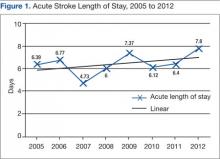Related: Does Stroke Hit Women Harder?
Standardized methods of acute stroke evaluation were implemented early in the program development and included the use of the National Institutes of Health Stroke Scale (NIHSS) and a bedside dysphagia screening process. Staff members responsible for these initial evaluations, specifically ED and intensive care unit nurses, were trained on the use of these tools, and electronic documentation templates were developed to facilitate the assessments. Comprehensive neurologic evaluation, including the essential elements of advanced stroke assessment, was also captured in standardized documentation templates for the neurology team.
The use of standardized practices and documentation templates helped the staff adhere to the requirements for the timely completion and documentation of the NIHSS to almost 100% consistently; however, it remains a challenge to consistently comply with the requirement to perform bedside dysphagia screens prior to oral intake (including medications). At the initiation of these measures, the dysphagia screen was performed for 58% of stroke patients; this rose to a fairly consistent 80% over time. Maintaining this percentage is a continual challenge that requires the SPC to work closely with the nursing staff, ED, and medicine teams.
Prior to and in the early phases of program implementation, the DVAMC effectively did not administer alteplase to patients with ischemic stroke, often because the requisite evaluations could not be completed in the required time frame. Since September of 2013, about 9 months after the program began, all 7 patients with AIS who qualified for treatment with alteplase were treated according to national guidelines. Continued work toward a goal of a < 60 minutes door-to-needle time is needed; but with notable progress, as door-to-needle time has decreased by 8% from the first alteplase administration to the most recent.
Overseen by the Simulations Department and the SPC, stroke code simulations (ie, mock stroke codes) are performed to aid in evaluating the acute stroke care process. Stroke simulation events should be an ongoing practice in any stroke program. It is an effective means to identify and address issues that may not otherwise be readily apparent.
Subacute Treatment
At DVAMC, postacute stroke care was identified as a priority. The SPC led a multidisciplinary team that was tasked with developing a postacute stroke care map, or integrated care pathway. Consistent care practices, a comprehensive tool to be used as a guide, can assist in improving outcomes, especially in a teaching facility with constantly changing medical and other clinical staff. The tool was developed using best practice guidelines from all disciplines. Staff members are encouraged to reference the pathway when caring for stroke patients, with necessary elements of care or performance measures in boldface to highlight their importance. Overall, DVAMC’s Best Care score (the percentage of patients whose care met all performance measures during the admission) rose from 57.1% to 78.6% over the course of the first year of the program.
Another key element of subacute stroke care is the provision of standardized patient stroke education. Before program initiation, stroke education at the DVAMC lacked consistency in both content and frequency. Secondary prevention should start at diagnosis, and education should be a continual process from admission to discharge. A patient booklet was developed that incorporated all required elements of stroke education per AHA guidelines: stroke risk factors, recognizing signs and symptoms, emergency activation, medications, and follow-up needs as well as other information, such as stroke pathophysiology, diet and activity, and managing lifestyle changes.7
Patient education templates were designed to facilitate documentation. Achieving this performance measure is a challenge not only for the DVAMC, but also for acute facilities nationwide. It requires involvement of the SPC as well as continual staff feedback and improvement challenges. Adherence to the patient education performance measure at the DVAMC improved from 0% meeting all 5 required elements at baseline to an average of 80% of patients.
A team of stroke champions representing each discipline involved in stroke care was recruited to be part of a postacute stroke team, led by the SPC. The team, consisting of neurologists, nurses, physical therapists, occupational therapists, speech therapists, nutritionists, social workers, and case managers, meets weekly for rounding on stroke patients, discussing patient care issues, assessing the effectiveness of the program, and addressing any system issues. This regular meeting facilitates collaboration and overall team building.
Rehabilitation and Follow-up
Routine physical, occupational, and speech therapy assessments are necessary to guide discharge planning. Although providing rehabilitation services is a priority, payer source can be a barrier to ideal rehabilitative care for DVAMC veterans. VA-based rehabilitation facilities are limited; therefore, community rehabilitation options, paid for by either VA funds or the patient’s insurance (if available), are used for the majority of stroke patients requiring these services. Efforts to increase access to stroke-specific rehabilitation options were undertaken by dedicated stroke champions at DVAMC; however, obtaining satisfactory payment agreements remains challenging.

